
95% of researchers rate our articles as excellent or good
Learn more about the work of our research integrity team to safeguard the quality of each article we publish.
Find out more
REVIEW article
Front. Clim. , 08 November 2022
Sec. Predictions and Projections
Volume 4 - 2022 | https://doi.org/10.3389/fclim.2022.1015225
This article is part of the Research Topic Interactions among Climates of Ocean Basins View all 8 articles
Northwest China is a typical arid and semi-arid region that is part of Central Asia. However, during the past 60 years, the climate in Northwest China has shown a warm and humid trend, with both average and extreme precipitation continuing to increase. Humidification in Northwest China is mainly caused by anomalous westward water vapor transport. Change in the water vapor transport path is directly related to the Mongolian anticyclone anomaly and weakening of the Asian summer monsoon. Our research shows that interdecadal changes in sea surface temperature (SST) in the North Atlantic, North Pacific, and Indian oceans, play an important role in interdecadal adjustment of atmospheric circulation and the wetting climate over Northwest China. Since the 1980s, the Indian Ocean has been warming continuously, and the land–sea thermal gradient has weakened, resulting in a significant reduction in water vapor transport of the Asian summer monsoon. In contrast, anomalous northerly water vapor transport from the polar region increased. Concurrently, SST over the North Atlantic is also warming, and the Atlantic multidecadal oscillation (AMO) changes from the negative to positive phase, triggering anomalous anticyclones over Mongolia, which also leads to weakening of the Asian summer monsoon. Therefore, eastern China is affected by abnormal northeast winds. These northeast winds can continuously transport water vapor to the western region of China, leading to the prevalence of easterly winds in Northwest China. Moreover, Pacific decadal oscillation (PDO) changed from the positive to negative phase after the 1990s, which promoted the East Asian westerly jet to move to the Arctic and produce easterly anomalies in East Asia and Northwest China. Interdecadal changes in SST over the Indian, North Atlantic, and North Pacific Oceans all have reduced summer water vapor from the Indian Ocean. However, water vapor from the North Pacific and high latitudes (including the polar region) can be transported to Northwest China through easterly anomalies, resulting in increased precipitation and climate humidification.
Northwest China (Figure 1), located in the center of the Eurasian continent, is one of the regions in the world where climate change is very significant and is one of the most sensitive regions to global climate change (Yang et al., 2017). Because of the distance from the ocean and blockage of humid airflow by the Qinghai-Tibet Plateau, this region has relatively low precipitation, which is typical of arid and semi-arid regions. In the early twenty-first century, Shi et al. (2003) took the lead in proposing that since the 1980s, Northwest China has experienced a climate transition from warm-dry to warm-wet, namely, as the climate warmed, temperatures, rainfall, and runoff increased significantly; glaciers are melting at speed, lake water level rose, wind and sandstorm days decreased, and vegetation has improved. Moreover, prediction results suggest that the warm and humid climate transition might be a century change (Zhou and Huang, 2010; Li et al., 2011, 2016; Wang et al., 2013, 2017; Chen et al., 2015; Ren et al., 2016; Li and Ma, 2018; Zhang et al., 2019). At that time, the period of precipitation increase was relatively short and the range of increase was relatively small. In addition, the increase in precipitation was partially offset by an increase in evapotranspiration caused by temperature rise, and there is a lack of convincing scientific explanation for the mechanism of precipitation increase. Therefore, there was no broad consensus on the problem of climate warming and humidification in Northwest China at that time (Zhang et al., 2021). In recent years, due to the obvious increase in precipitation and improvement in ecological vegetation in Northwest China, climate warming and wetting have once again become an important scientific issue of concern to Chinese academia, and more attention has been paid to the causes and mechanisms of the phenomenon.
Studies have found that the East Asian summer monsoon has shown a weakening trend in recent decades, but the frequency and strength of monsoonal transport to Northwest China have significantly increased since 1958, especially since 1985, causing increasing trends of precipitation (Huang et al., 2015; Chen C. et al., 2021; Chen F. H. et al., 2021). Chen C. et al. (2021), Chen F. H. et al. (2021) believe that weakening of the East Asian summer monsoon is in step with the westward shift of the western Pacific subtropical high and strengthening of the Mongolian anticyclone activity, which promotes westward transportation of summer water vapor from the Indian and Pacific Oceans. Owing to the sustained east wind generated by the Mongolian anticyclone in northern China, westward transportation of water vapor can be further transported to Northwest China along the northern periphery of the Tibetan Plateau, which is important for the increase in precipitation in Northwest China. Additionally, under global warming, changes in sea surface temperature (SST) over the Pacific, Indian, and Atlantic Oceans are considered to affect westerly and monsoonal water vapor transport, thus affecting precipitation in East Asia and Northwest China (Si and Ding, 2016; Li et al., 2017; Liu, 2018; Lu et al., 2019; Shang et al., 2019).
Since 1961, precipitation in most parts of Northwest China has been increasing, and this increase is mainly reflected in the increase in annual and seasonal precipitation. From the perspective of the decadal scale, Northwest China experienced an obvious interdecadal shift around the mid-1980s, with greatly increased precipitation thereafter (Figure 2). Notably, the trend distribution for precipitation was different between the western and eastern areas of Northwest China (Figure 3). The western area of Northwest China has undergone an obvious wetting trend, however, the change over the eastern area of Northwest China has been a drying trend until this century (Ren et al., 2016; Liu et al., 2019; Shang et al., 2019; Wu et al., 2019; Zhang et al., 2019; Wang et al., 2020). Recent research has shown that precipitation over the eastern area of Northwest China has also increased this century. Therefore, both eastern and western parts of Northwest China entered a period of precipitation increase (Ren et al., 2016; Ma et al., 2020). Additionally, precipitation days in the western parts of Northwest China increased but decreased in the eastern parts. However, precipitation intensity increased in most areas of Northwest China, which was affected by climate warming (Figure 4). The start and end dates of extreme precipitation were advanced and postponed, respectively. Extreme precipitation made a prominent contribution to annual precipitation over Northwest China, and precipitation intensity and days above heavy rainfall in the summer have significantly increased in some regions (Han et al., 2020; Lu et al., 2021).
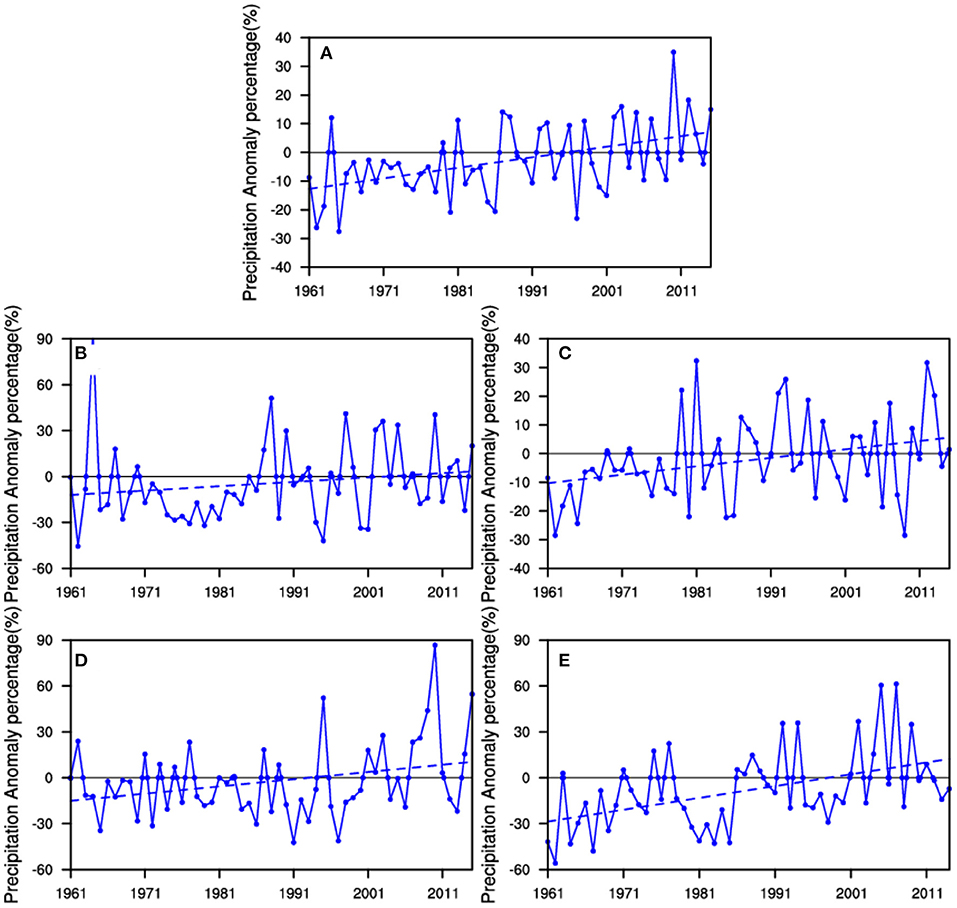
Figure 2. Variation of precipitation anomaly percentages over Northwest China [dashed lines denote linear trends; (A) annual, (B) spring, (C) summer, (D) autumn, (E) winter; unit: %] (Wu et al., 2019).
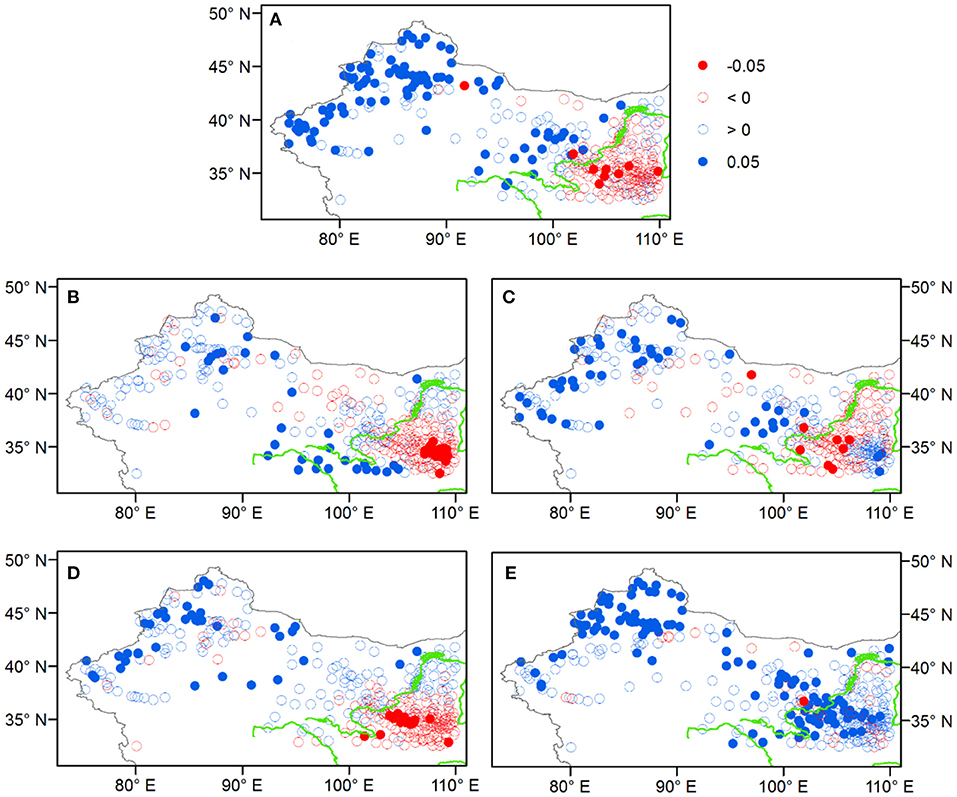
Figure 3. Variation distribution of change trends to precipitation over Northwest China [blue/red solid circles denote obvious increase/decrease; blue/red hollow circles denote no obvious increase/decrease; (A) annual, (B) spring, (C) summer, (D) autumn, (E) winter] (Wu et al., 2019).
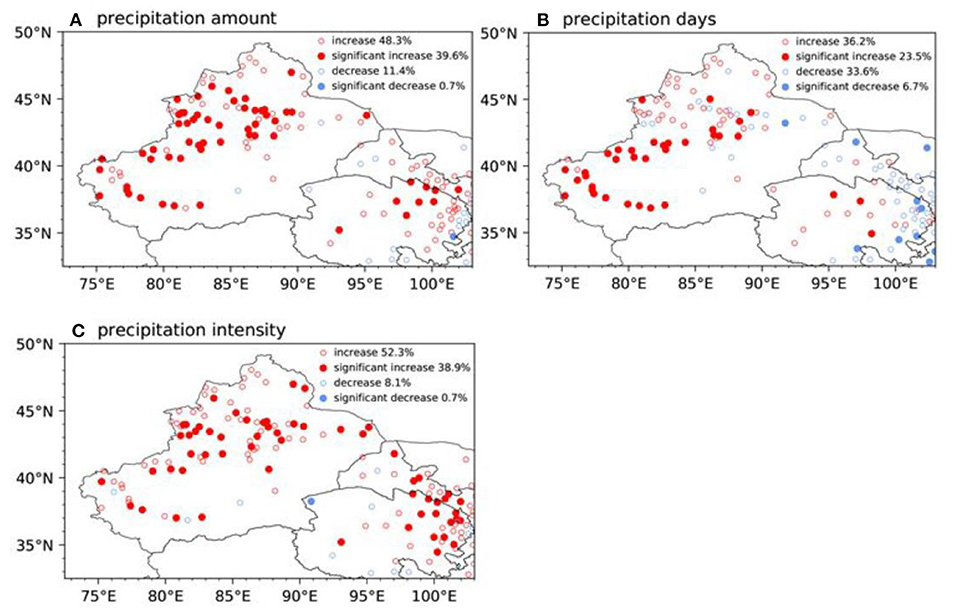
Figure 4. Interdecadal variation distribution of (A) summer precipitation amount, (B) precipitation days, and (C) precipitation intensity over Northwest China (Xue et al., 2022).
With climate warming over Northwest China, increase in water vapor transport plays a significant role in the interdecadal increase in precipitation (Peng and Zhou, 2017; Wu et al., 2019; Chen C. et al., 2021). By estimating water vapor budget (Figure 5), summer monsoon water vapor transport from the southern boundary decreased, whereas outflow at the eastern boundary decreased more during the wet period of 1991–2018 in Northwest China (Wu et al., 2022). Anomalous water vapor transport from easterly winds was considered the main source of precipitation increase in Northwest China (Figure 6) (Chen C. et al., 2021; Wu et al., 2022). Variation in water vapor transport was directly related to the Mongolian anticyclone anomaly and weakening of the Asian summer monsoon.
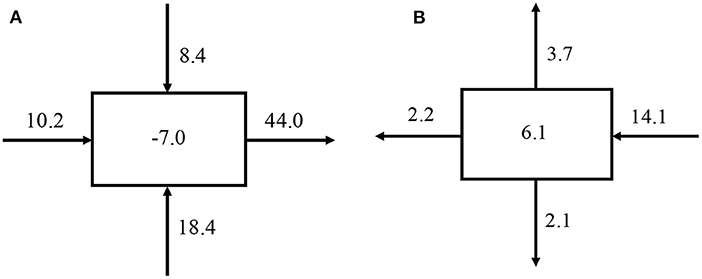
Figure 5. Boundary moisture budget anomalies over Northwest China during (A) 1961–1990 and (B) 1991–2018 (unit: 106 kg/s) (Wu et al., 2022).
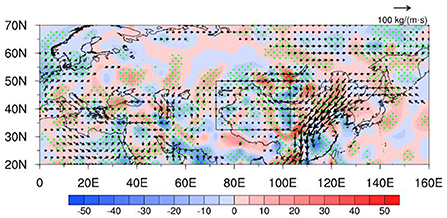
Figure 6. Vertically integrated water vapor flux anomalies (arrows, unit: kg m−1 s−1) and water vapor flux divergence anomalies (shading, unit: 10−6 kg m−2 s−1) in the summer. Green dots indicate significance at the 95% confidence level (Xue et al., 2022).
SST changes have a direct effect on atmospheric circulation, which influences interdecadal climate variation through ocean-atmosphere interaction. Interaction of the Pacific, Atlantic, and Indian Oceans, can trigger or regulate global climate change (Wang, 2019). Many studies have found that the three oceans affect atmospheric circulation over East Asia through atmospheric teleconnection, and then modulate precipitation in Asia (Si and Ding, 2016; Zhu et al., 2016; Li et al., 2017; Liu, 2018). Interdecadal variation of precipitation in Northwest China is also controlled by ocean-atmosphere interaction and is related to interdecadal pressurization of the three oceans to varying degrees (Shang et al., 2019; Ma et al., 2020; Wu et al., 2022).
When studying the influence of SST on precipitation in Northwest China, Shang et al. (2019) found that SST anomalies over the tropical Central-Eastern Pacific showed obvious positive anomalies during 1989–1998, suggesting an Eastern Pacific El Niño-Southern Oscillation, and the mid-latitude North Pacific showed negative anomalies. During 1999–2010, the change in Pacific SST was contrary to that during 1989–1998 (Figure 7). The difference between the two periods shows that the North Pacific SST had a Pacific decadal oscillation (PDO) distribution. In different stages, the relationship between PDO phase change and precipitation in Northwest China differs. Before the 1980s, PDO was in the negative phase (Figure 8), and precipitation was low. From the 1980s to the 1990s, PDO was in the positive phase, and precipitation was in a stage of increasing fluctuation. In the 1990s, PDO changed from the positive to negative phase, however, precipitation showed a significant increasing trend. Concurrently, precipitation in Northwest China has undergone an increasing decadal transition. Lau et al. (2004) found that the phase transition of PDO could adjust the influence of the East Asian westerly jet on precipitation distribution in China. The negative phase of PDO can produce obvious easterly anomalies over East Asia, and the East Asian westerly jet weakens and moves toward the poles. As shown in Figure 9, the East Asian westerly jet moves southward in the positive phase of PDO, which affects Northwest China by creating easterly anomalies and producing an anomalous upward movement, which is conducive to increasing precipitation in Northwest China.
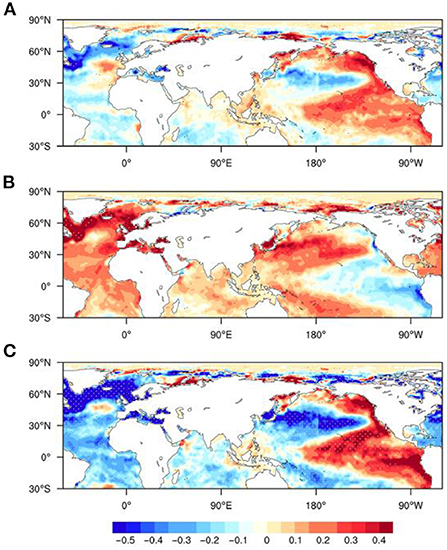
Figure 7. Summer SST anomaly distribution (A) 1989–1998; (B) 1999–2010; (C) the difference between 1989–1998 and 1999–2010. Dotted area indicates significance at the 95% confidence level (Shang et al., 2019).
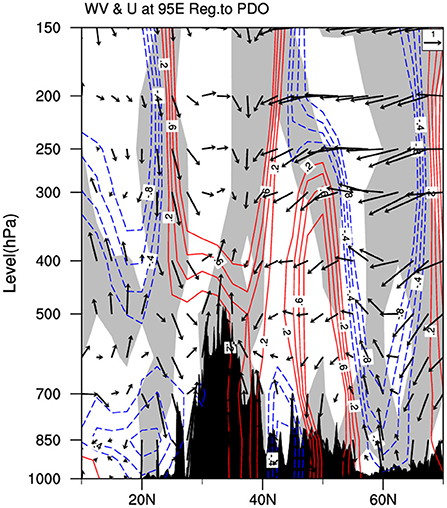
Figure 9. Regression of meridional-vertical wind (vectors) and zonal wind (contours) along 95°E against the PDO index. Unit of vertical velocity ω is 0.2 × 10−2 Pa/s, and unit for zonal wind u and meridional wind v is m/s. Shaded areas denote significance at the 95% confidence level.
The Atlantic multidecadal oscillation (AMO) is a quasi-periodic warm and cold abnormal change in SST with a basin scale in space and multi-decade scale in time in the North Atlantic. Its cycle is 65–80a, which is the natural variability of the climate system. Studies have found that AMO had an important impact on the world climate and in China (Si and Ding, 2016; Li et al., 2017). AMO can affect its downstream region through teleconnection generated by Rossby wave energy propagation (Li et al., 2017; Liu et al., 2019). In the warm AMO phase, cyclonic and anticyclonic circulation in the upper troposphere are alternately arranged along the Rossby propagation path. In East Asia, sea level pressure has a positive—negative—positive distribution, and vertical coupling between the anticyclone at the upper level and low pressure at the lower level is conducive to forcing upper-level divergence. This up-down coupling circulation is conducive to an ascending motion in Northern China and increasing precipitation in this region. In the AMO cold phase, the opposite result was obtained (Figure 10).
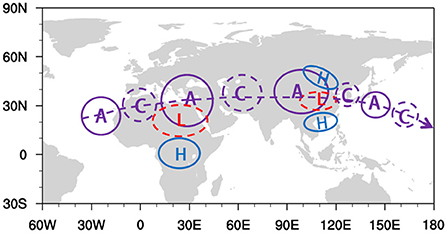
Figure 10. Schematic diagram of the teleconnection effect of the AMO warm phase to the Asian summer monsoon precipitation (L and H indicate surface anomalous warm cyclone and subtropical anticyclone systems, respectively; A and C indicate anomalous anticyclones and cyclones in the upper troposphere, respectively; dotted line with arrow represents the teleconnection wave train during the AMO warm phase) (Li et al., 2017).
Over the past 60 years, precipitation in Northwest China has experienced interdecadal humidification from less to more in the mid-1980s, which is consistent with interdecadal transition from the cold phase to warm phase of the AMO at the same time (Figure 11). The AMO warm phase can trigger a Rossby wave propagating along the East Asian westerly jet stream (Wu and Zhou, 2016; Wu et al., 2022). During the AMO warm phase, the Aleutian Islands and Japan were affected by anomalous anticyclones, which increased moisture transport from high-latitudes and the North Pacific toward Northwest China due to anomalous easterly winds on the south side of the Mongolia Baikal Lake anticyclone (Figure 12). In addition, with an increase in atmospheric instability and upward movement, precipitation in Northwest China increases. Therefore, the AMO may be one of the main reasons for interdecadal variation in summer precipitation in Northwest China.
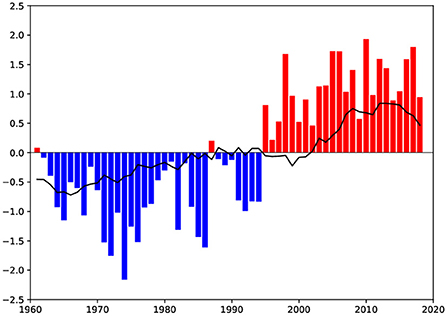
Figure 11. Time series of AMO indices (the black line is the normalized summer precipitation index).
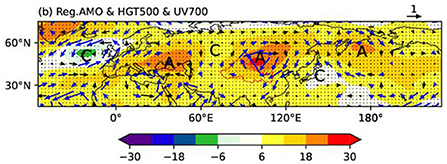
Figure 12. Regression of geopotential height at 500 hPa (shading, unit: gpm) and winds at 700 hPa (vectors, unit: m/s) against the AMO index (a). A and C denote the centers of anomalous anticyclones and cyclones, respectively. Blue arrows and black dots denote significance at the 95% confidence level (Wu et al., 2022).
Since the 1980s, the equatorial and southern Indian Oceans have warmed significantly in summer, while there has been no significant trend in temperature over the Indian subcontinent (Figure 13). The land-sea thermal and sea-level pressure gradients have declined, weakening the strength of the Indian summer monsoon (Gao et al., 2018). It can be seen from Figure 14 that Indian Ocean SST has changed from the cold phase to warm phase since the mid-1980s. Warming of the Indian Ocean can induce anomalous high-pressure centers near Mongolia Baikal Lake and the Aleutian Islands at 500 hPa, and anticyclone circulation anomalies at 700 hPa (Figure 15). Moreover, warming of the Indian Ocean led to the generation of anomalous northerlies over East Asia and weakened the Indian summer monsoon, which reduced the warm and wet water vapor transported from the Indian Ocean and the South China Sea to the central and eastern parts of China, while increasing moisture transport from the Arctic and North Pacific to Northwest China with the Mongolian anticyclone anomaly providing favorable moisture conditions for increase in precipitation over Northwest China (Wu et al., 2022).
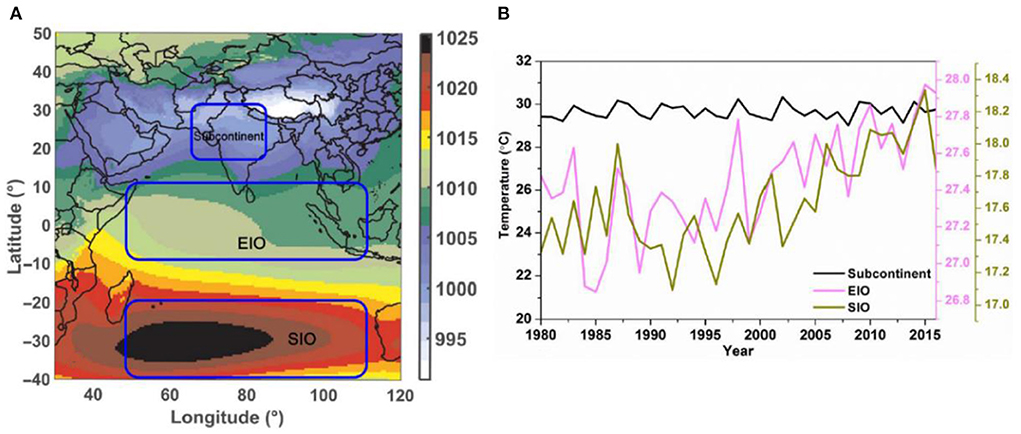
Figure 13. Decadal trend of temperature for specific regions. (A) Sea level pressure averaged over 1980–2016 and (B) time series of temperature averaged over the Indian subcontinent, equatorial and southern Indian Oceans (regions marked with blue boxes on the left) (Gao et al., 2018).
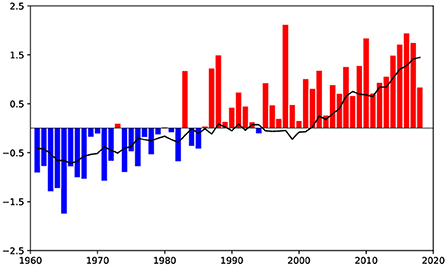
Figure 14. Time series of Indian Ocean SST anomaly indices (the black line is the normalized summer precipitation index).
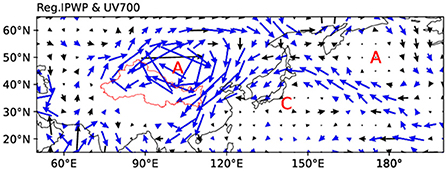
Figure 15. Regression of winds at 700 hPa (vectors, unit: m/s) against the Indian Ocean SST anomaly index. A and C denote the centers of anomalous anticyclones and cyclones, respectively. Blue arrows denote significance at the 95% confidence level (Wu et al., 2022).
With global warming becoming increasingly obvious in the late twentieth century, the climate in Northwest China has also been significantly affected. Over the past 60 years, precipitation in Northwest China has shown a significant increasing trend, which is still intensifying. Before the twenty-first century, precipitation showed a significantly increasing trend over the western area of Northwest China but an obviously decreasing trend over the eastern area of Northwest China. However, since this century, the humidification area has expanded eastward and the eastern and western areas have shown consistent humidification which is not only reflected in the increase in average precipitation, but also in the increase in extreme precipitation. The increase in extreme precipitation has contributed prominently to the increase in annual precipitation in Northwest China.
Under global warming, the interdecadal transformation of SST over the North Atlantic, North Pacific, and Indian Oceans has an important impact on global climate and climate change in Northwest China. Since the 1980s, the warmer Indian Ocean has contributed to a significant decrease in summer monsoon water vapor transport. At the same time, the AMO changed from the negative to positive phase, which can trigger the Mongolian anticyclone circulation anomaly, leading to the weakening of the Asian summer monsoon and affecting Northwest China under moderation of the easterly air flow. After the 1990s, PDO changed from the positive to negative phase, which changed position of the westerly jet in East Asia, resulting in easterly anomalies in East Asia and Northwest China. Interdecadal changes in SST over the Indian, North Atlantic, and Pacific Oceans all reduce summer water vapor transport in Asia and cause easterly anomalies in Northwest China. In the future, water vapor will be transported from the North Pacific and high latitudes into Northwest China, resulting in more precipitation.
This study expounds on how the three oceans affect climate change over Northwest China, but it does not explain how they cooperate with climate change, especially when the timing of phase transitions of the PDO, AMO, and Indian Ocean warming are not consistent with each other. Since the 1990s, PDO has changed from the positive to negative phase, while precipitation in Northwest China has increased rapidly. Whether the influence of PDO on precipitation change in Northwest China is weakening, while the influence of SST change in the North Atlantic and Indian Oceans is increasing, needs to be further studied. In addition, there is no conclusion on how changes in SST over the three oceans quantitatively affects the increase in extreme precipitation over Northwest China. These problems need to be studied in the future. In the past two decades, the Arctic has been warming rapidly and sea ice has decreased sharply (Screen and Simmonds, 2010; Stroeve et al., 2011). Zeng and Sun (2021) found that decadal decrease of sea ice over the Barents Sea intensified the Mongolian high, which may indicate that warming of the Arctic and reduction of sea ice also contributes to climate humidification in Northwest China.
YD and PW: writing—original draft preparation. YL: writing—review and editing. All authors agree to be accountable for the content of the work. All authors contributed to the article and approved the submitted version.
This study was supported by the Second Tibetan Plateau Scientific Expedition and Research (STEP) program (Grant Numbers 2019QZKK0208 and 2019QZKK0102), and National Natural Science Foundation of China (Grant Number 41801017).
We thank all colleagues in the climate change research in the Northwest China in for their help in writing this review.
The authors declare that the research was conducted in the absence of any commercial or financial relationships that could be construed as a potential conflict of interest.
All claims expressed in this article are solely those of the authors and do not necessarily represent those of their affiliated organizations, or those of the publisher, the editors and the reviewers. Any product that may be evaluated in this article, or claim that may be made by its manufacturer, is not guaranteed or endorsed by the publisher.
Chen, C., Zhang, X., Lu, H., Jin, L., Du, Y., and Chen, F. (2021). Increasing summer precipitation in arid central Asia linked to the weakening of the East Asian summer monsoon in the recent decades. Int. J. Climatol. 41, 1024–1038. doi: 10.1002/joc.6727
Chen, F. H., Chen, J., and Huang, W. (2021). Weakened East Asian summer monsoon triggers increased precipitation in Northwest China. Sci. China Earth Sci. 64, 7. doi: 10.1007/s11430-020-9731-7
Chen, Y. N., Li, Z., Fan, Y. T., Wang, H., and Deng, H. (2015). Progress and prospects of climate change impacts on hydrology in the arid region of northwest China. Environ. Res. 139, 11–19. doi: 10.1016/j.envres.2014.12.029
Gao, M., Ding, Y. H., Song, S. J., Lu, X., Chen, X., and McElroy, M. B. (2018). Secular decrease of wind power potential in India associated with warming in the Indian Ocean. Sci. Adv., 4, eaat5256. doi: 10.1126/sciadv.aat5256
Han, T. T., Guo, X. Y., Zhou, B. T., Hao, X. (2020). Recent changes in heavy precipitation events in Northern Central China and associated atmospheric circulation. Asia-Pacific J. Atmos. Sci. 20, 1. doi: 10.1007/s13143-020-00195-1
Huang, W., Feng, S., Chen, J., Chen, F. (2015). Physical mechanisms of summer precipitation variations in the Tarim Basin in northwestern China. J. Climate 28, 3579–3591. doi: 10.1175/JCLI-D-14-00395.1
Lau, K. M., Lee, J. Y., Kim, K. M., Kang, I. S. (2004). The North Pacific as a regulator of summertime climate over Eurasia and North America. J. Climate, 17, 819–833. doi: 10.1175/1520-0442(2004)017andlt;0819:TNPAARandgt;2.0.CO;2
Li, B. F., Chen, Y. N., Chen, Z. S., Xiong, H. G., and Lian, L. S. (2016). Why does precipitation in Northwest China show a significant increasing trend from 1960 to 2010. Atmos. Res. 167, 275–284. doi: 10.1016/j.atmosres.2015.08.017
Li, M. X., and Ma, Z. G. (2018). Decadal changes in summer precipitation over arid northwest China and associated atmospheric circulations. Int. J. Climatol. 38, 4496–4508. doi: 10.1002/joc.5682
Li, Q. H., Chen, Y. N., Shen, Y. J., Li, X.G., and Xu, J.H. (2011). Spatial and temporal trends of climate change in Xinjiang, China. J. Geograph. Sci. 21, 1007–1018. doi: 10.1007/s11442-011-0896-8
Li, Y., Ding, Y. H., and Li, W. J. (2017). Interdecadal variability of the Afro-Asian summer monsoon system. Adv. Atmos. Sci. 34, 833–846. doi: 10.1007/s00376-017-6247-7
Liu, J. P. (2018). Interdecadal variabilities and mechanisms of Southern China summer rainfall. University of Chinese Academy of Sciences, China. (in Chinese).
Liu, W. C., Zhao, F., Chen, X. Y., Qu, J., Wang, J.X., and Peng, X. (2019). Inhomogeneity of precipitation and its influencing factors in Northwest China from 1961 to 2015. Theor. Appl. Climatol. 138, 1831–1844. doi: 10.1007/s00704-019-02907-8
Lu, B., Li, H. Y., Wu, J., Zhang, T.X., Liu, J., Liu, B., et al. (2019). Impact of el nino and southern oscillation on the summer precipitation over northwest china. Atmos. Sci. Lett. 19, e928. doi: 10.1002/asl.928
Lu, S., Hu, Z. Y., Yu, H. P., Fan, W.W., Fu, C.W., and Wu, D. (2021). Changes of extreme precipitation and its associated mechanisms in Northwest China. Adv. Atmosph. Sci. 38, 1665–1681. doi: 10.1007/s00376-021-0409-3
Ma, P. L., Yang, J. H., and Lu, G. Y. (2020). The transitional change of Climate in the East of Northwest China. Plateau Meteorol. 39, 840–850. doi: 10.7522/j.issn.1000-0534.2019.00093
Peng, D. D., and Zhou, T. J. (2017). Why was the arid and semiarid northwest China getting wetter in the recent decades? J. Geophysic. Res. Atmosph. 122, 9060–9075. doi: 10.1002/2016JD026424
Ren, G. Y., Yuan, Y. J., Liu, Y. J., Ren, Y.Y, Wang, T., and Ren, X.Y. (2016). Changes in precipitation over Northwest China. Arid Zone Res. 33, 1-19 (in Chinese). doi: 10.13866/j.azr.2016.01.01
Screen, J. A., and Simmonds, I. (2010). Increasing fall-winter energy loss from the Arctic Ocean and its role in Arctic temperature amplification. Geophys. Res. Lett. 37, 16. doi: 10.1029/2010GL044136
Shang, S. S., Zhu, G. F., Li,. R. L., Xu, J., Gu, J., Chen, H.L., et al. (2019). Decadal change in summer precipitation over the east of Northwest China and its associations with atmospheric circulations and sea surface temperatures. Int. J. Climatol., 40, 3731–3747. doi: 10.1002/joc.6424
Shi, Y. F., Shen, Y. P., Li, D. L., Zhang, G.W., Ding, Y.J., Hu, R.J., et al. (2003). Discussion on the present climate change from warm-dry to warm-wet in Northwest China. Quaternary Sciences, 23, 152–164. Available online at: http://en.igg-journals.cn/article/id/dsjyj_9211
Si, D., and Ding, Y. H. (2016). Oceanic forcings of the interdecadal variability in East Asian summer rainfall. J. Climate 29, 7633–7649. doi: 10.1175/JCLI-D-15-0792.1
Stroeve, J. C., Maslanik, J., Serreze, M. C., Rigor, I., Meier, W., and Fowler, C. (2011). Sea ice response to an extreme negative phase of the Arctic Oscillation during winter 2009/2010. Geophys. Res. Lett. 38, L02502. doi: 10.1029/2010GL045662
Wang, C. (2019). Three-ocean interactions and climate variability: a review and perspective. Climate Dynam. 53, 5119–5136. doi: 10.1007/s00382-019-04930-x
Wang, H. J., Chen, Y. N., and Chen, Z. S. (2013). Spatial distribution and temporal trends of mean precipitation and extremes in the arid region, northwest of China, during 1960–2010. Hydrologic. Process.27, 1807–1818. doi: 10.1002/hyp.9339
Wang, Q., Zhai, P. M., and Qin, D. H. (2020). New perspectives on ‘warming-wetting' trend in Xinjiang, China. Adv. Climate Change Res., 11: 252-260. doi: 10.1016/j.accre.2020.09.004
Wang, Y. J., Zhou, B. T., Qin, D. H., Wu, J., Gao, R., Song, L.C. (2017). Changes in mean and extreme temperature and precipitation over the arid region of northwestern China: observation and projection. Adv. Atmosphere. Sci. 34, 289–305. doi: 10.1007/s00376-016-6160-5
Wu, P., Ding, Y. H., Liu, Y. J., and Li, X. C. (2019). The characteristics of moisture recycling and its impact on regional precipitation against the background of climate warming over Northwest China. Int. J. Climatol. 39, 5241–5255. doi: 10.1002/joc.6136
Wu, P., Liu, Y. J., and Ding, Y. H. (2022). Modulation of Sea Surface Temperature over the North Atlantic and Indian-Pacific warm pool on interdecadal change of summer precipitation over Northwest China. Int. J. Climatol. 20, 7743. doi: 10.1002/joc.7743
Wu,. B, and Zhou,. T. (2016). Interdecadal circumglobal teleconnection pattern during boreal summer driven by AMO. Atmosphere. Sci. Lett. 17, 446–452. doi: 10.1002/asl.677
Xue, T., Ding, Y. H., and Lu, C. H. (2022). Analysis of the interdecadal variation and causes of summer precipitation in Northwest China. J. Meteorologic. Res. doi: 10.1007/s13351-022-2021-6
Yang, P., Xia, J., Zhan, C., Zhang, Y.Y, and Hu, S. (2017). Discrete wavelet transformbased investigation into the variability of standardized precipitation index in Northwest China during 1960–2014. Theor. Appl. Climatol. 132:167–180. doi: 10.1007/s00704-017-2063-3
Zeng, Z. X., and Sun, J. Q. (2021). Decadal change of extreme consecutive dry days in spring over the middle and lower reaches of the Yangtze River around the early 2000s: The synergistic effect of mega-El Nino/Southern Oscillation, Atlantic Multidecadal Oscillation, and Arctic sea ice. Atmos. Res. J.Atmosres. 2021, 105936. doi: 10.1016/j.atmosres.2021.105936
Zhang, Q., Lin, J. J., Liu, W. C., and Han, L.Y. (2019). Precipitation seesaw phenomenon and its formation mechanism in the eastern and western parts of Northwest China during the flood season. Sci. China Earth Sci. 62, 2083–2098. doi: 10.1007/s11430-018-9357-y
Zhang, Q., Yang, J., Wang, W., Ma, P.L., Lu, G.Y., Liu, X., et al. (2021). Climatic warming and humidification in the arid region of Northwest China: multi-scale characteristics and impacts on ecological vegetation. J. Meteorol. Res. 35, 113–127. doi: 10.1007/s13351-021-0105-3
Zhou, L. T., and Huang, R. H. (2010). Interdecadal variability of summer rainfall in Northwest China and its possible causes. Int. J. Climatol. 30, 549–557. doi: 10.1002/joc.1923
Keywords: Northwest China, wetting, water vapor transport, AMO, PDO, Indian Ocean SST
Citation: Ding Y, Wu P and Liu Y (2022) Modulation of sea surface temperature in three oceans on precipitation increase over Northwest China during the past 60 years: A review. Front. Clim. 4:1015225. doi: 10.3389/fclim.2022.1015225
Received: 09 August 2022; Accepted: 06 October 2022;
Published: 08 November 2022.
Edited by:
Carlos R. Mechoso, University of California, Los Angeles, United StatesReviewed by:
Bian He, Institute of Atmospheric Physics (CAS), ChinaCopyright © 2022 Ding, Wu and Liu. This is an open-access article distributed under the terms of the Creative Commons Attribution License (CC BY). The use, distribution or reproduction in other forums is permitted, provided the original author(s) and the copyright owner(s) are credited and that the original publication in this journal is cited, in accordance with accepted academic practice. No use, distribution or reproduction is permitted which does not comply with these terms.
*Correspondence: Ping Wu, d3VwQGNtYS5nb3YuY24=
Disclaimer: All claims expressed in this article are solely those of the authors and do not necessarily represent those of their affiliated organizations, or those of the publisher, the editors and the reviewers. Any product that may be evaluated in this article or claim that may be made by its manufacturer is not guaranteed or endorsed by the publisher.
Research integrity at Frontiers

Learn more about the work of our research integrity team to safeguard the quality of each article we publish.